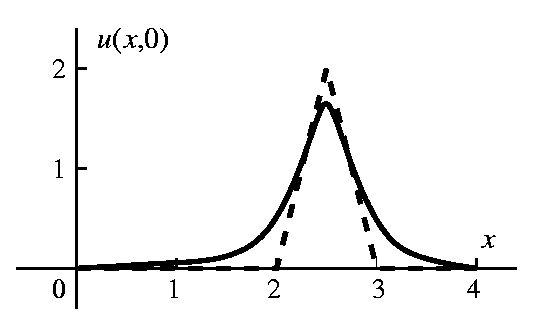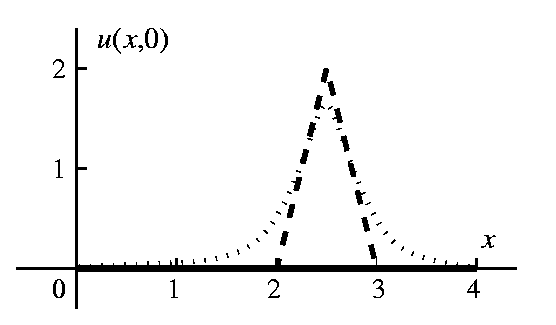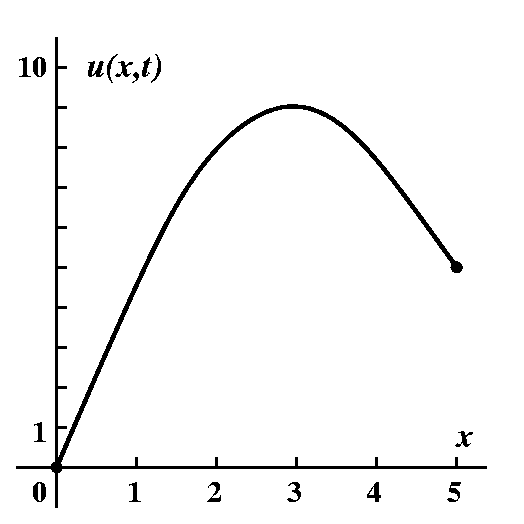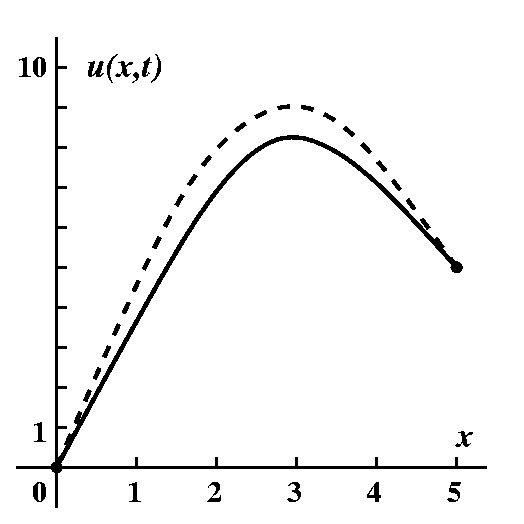Answers to review problems for the third exam
in Math
421, spring 2004
| Most (but not all) of the problems are written so that computations of integrals are not needed! Again, thanks to Professor N. Komarova for many of these problems and for contributing to some of the answers. |
![]() means no answer is
available yet. But now they're all here!
means no answer is
available yet. But now they're all here!
| #1 | #2 | #3 | #4 | #5 | #6 | #7 | #8 | #9 | #10 | #11 | #12 | #13 | #14 | #15 | #16 | #17 |
|
4. Calculate the Fourier series of the functions given (all defined on
the interval [-Pi,Pi]):
a) f(x)=-1 if x=<0 and 2 if x>0. b) f(x)=5. c) f(x)=21+2sin(5x)+8cos(2x). d) f(x)=SUMn=18cnsin(nx); cn=1/n. e) f(x)=-4+SUMn=16(cnsin(nx)+7cos(nx)) ; cn=(-1)n. Answer
Answer to a): if n>0, an=(1/Pi) Now a0 is (1/Pi)(the integral of f(x) from -Pi to Pi), which is 1. Why are all the other an's equal to 0? There is a simple reason. We can write f(x)=(1/2)+(another function)? The "another function" here is -3/2 on [-Pi,0) and 3/2 on (0,Pi]. So "another function" is odd and its cosine Fourier coefficients are all 0. Therefore f(x)'s cosine Fourier coefficients, except for the constant (n=0) one, are all 0.
The sine coefficients: The total integral is (3/n)[1-cos(n·Pi)] because the antiderivative of sine is -cosine, and because cos(0)=1 and cos(-w)=cos(w). Now cos(n·Pi)=(-1)n, so that bn=(3/n)[1+(-1)n+1]. The Fourier series of f(x) is therefore (1/2)+SUMn=1infinity(3/n)[1+(-1)n+1]sin(nx).
|
|
5. a) Suppose f(x)=x+x3 for x in [-Pi,Pi]. Which coefficients
of the Fourier series of f(x) must be 0?
b) Suppose f(x)=cos(x5)+sin(x2) for x in [-Pi,Pi]. Which coefficients of the Fourier series of f(x) must be 0? Answer b) g(x) is an even function. Indeed, g(-x)=cos((-x)5)+sin((-x)2)=cos(-x5)+sin(x2)=cos(x5)+sin(x2)=g(x). Therefore all the nn's must be 0 (the sine coefficients).
|
|
6. Suppose f(x)=x+x4 for x in [0,Pi].
a) If F(x) is the odd extension of f(x) to [-Pi,Pi], write a formula or formulas for F(x). Which terms must be 0 in the Fourier series of F(x)? b) If G(x) is the even extension of f(x) to [-Pi,Pi], write a formula or formulas for G(x). Which terms must be 0 in the Fourier series of G(x)? Answer b) G(x) is x+x4 for x>0, and G(x) is -x+x4 for x<0. Then we know that G(-x)=G(x) so G(x) is even. For an even function, the sine coefficients are 0: what we generally call the bn's.
|
|
7. Suppose f(x)=2e-4x for x in [0,Pi]. Another function,
F(x), is given by F(x)=SUMn=0infinity
bnsin(nx),
where bn=(2/Pi) Answer For the negative values of x, the sine series converges to the odd extension of f(x). That is, F(x)=-f(-x) for x<0. Therefore F(x)=-2e^{4x} for x<0 so that F(-2)=-2e-8.
Question from the Management
|
|
8. Both ends of a string of length 25 cm are attached to fixed
points at height 0. Initially, the string is at rest, and has the
shape 4sin([2Pi x]/25}), where x is the
horizontal coordinate along the string, with 0 at the left end. The
speed of wave propagation along the string is 3 cm/sec. Write the
initial and boundary value problem for the shape of the
string.
Answer
|
|
9. Suppose the following boundary value problem is given: ytt=yxx for x in [0,Pi]; y(0,t)=y(Pi,t)=0; y(x,0)=5sin(2x)+8sin(6x); yt(x,0)=0. Find y(x,t). Answer
|
|
10. Suppose the following boundary value problem is given: ytt=50yxx for x in [0,100]; y(0,t)=y(100,t)=0; y(x,0)=x2(100-x); yt(x,0)=x for x in [0,25] and (1/3)(100-x) for x in (25,100]. What is the speed of wave propagation along the string? What is the initial displacement of the string at the point x=20? What is the initial velocity of the string at the point x=50? At what point of the string is the initial velocity the largest? Answer
|
|
11. Suppose the following boundary value problem is given: ytt=50yxx for x in [0,Pi]; y(0,t)=y(Pi,t)=0; y(x,0)=0; yt=g(x).
Suppose we also know
Answer
|
|
12. Use separation of variables to analyze the equation
yt=12y-5yx+7yxx.
That is, reduce this partial differential equation to some ordinary differential equations. Explain every step.
Answer
Now divide both sides by X(x)T(t):
The left hand side does not depend on x. The right had side does not
depend on t. They are equal to each other. Therefore, both the left
hand side and the right hand side are constants. We set the constant
to be -
|
|
13. Consider this wave equation and initial value problem
on the whole real line, R:
ytt=9yxx for x in R; y(x,0)=x(2-x) for x in [0,2] and y=0 otherwise; yt(x,0)=0 for x in R. a) Find y(x,t). b) Draw the solution for t=5 and t=10 (two graphs). c) How long will it take before an observer located at point x=27 receives a signal?
Answer
But what is f(x)? It is actually not the simple algebraic
x(2-x), but (since we're going to substitute x-/+3t in for x) a
function which is equal to x(2-x) in [0,2] but is 0 otherwise. Here is
a way of writing this, using the Heaviside function from Laplace
transforms: Now I can write y(x,t). It is (1/2){[x-3t](2-[x-3t])H([x-3t])H(2-[x-3t])+[x+3t](2-[x+3t])H([x+3t])H(2-[x+3t])}. b)
The graphs are two bumps half the height of the original profile. One is traveling left and the other, right. The speed is 3 distance units per time unit. The original bump is centered at x=1. For t=5, the bumps are centered at -14 and 16. For t=10, they are centered at -29 and 31. I have drawn the horizontal and vertical axes with different units. c) The right edge of the bump moving right will reach x=27 at time (27-2)/3=25/3.
|
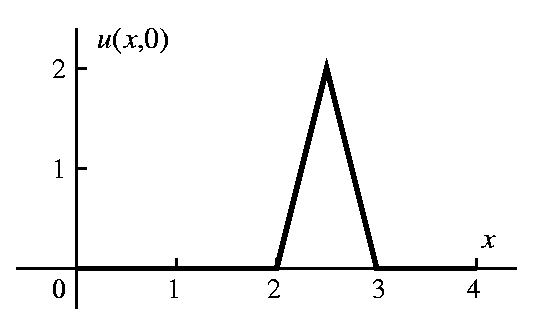 14. The graph displays an initial (t=0) temperature
distribution for u(x,t), the temperature on an insulated
bar 4 cm long satisfying
the heat equation
ut=uxx
and the boundary conditions u(0,t)=0 and
u(4,t)=0 for all t.
14. The graph displays an initial (t=0) temperature
distribution for u(x,t), the temperature on an insulated
bar 4 cm long satisfying
the heat equation
ut=uxx
and the boundary conditions u(0,t)=0 and
u(4,t)=0 for all t.
a) Sketch a graph of u(x,1/100) and a graph of u(x,100). b) Explain why this initial temperature distribution can't result from an earlier temperature distribution.
Answers
b) The initial temperature distribution shown is not smooth: more precisely, it is not differentiable at x=2 and x=2.5 and x=3. Temperature distributions which are the result of the time "evolution" of earlier temperature distributions must be smooth. Therefore this initial temperature distribution is not the "evolution" of an earlier temperature distribution.
|
|
15. Suppose an insulated bar of length Pi cm also has insulated
ends. An initial temperature distribution is given by f(x)=2 for x in
[0,Pi/2] and 4 for x in (Pi/2,Pi]. a) Write the initial and boundary value problem for u(x,t), the temperature of the bar. b) Write the solution, u(x,t). c) What is the limiting temperature distribution as t-->infinity?
Answer
b)
u(x,t)=[c0/2]+SUMc=1infinitycncos(nx)e-kn2t
where: c) The limiting temperature distribution is the constant 3 (that's c0/2, or the average of the initial temperature, f(x).) All of the exponentials with negative constants force the other terms to 0 very rapidly.
|
|
16. Suppose an insulated bar of length 10 cm has insulated ends.
Find the temperature distribution as t-->infinity if:
a) The initial temperature distribution is given by f(x) where f(x)=0 if x is in [0,1], 2 if x is in (1,2], 0 if x is in (2,3], 5 if x is in (3,4], and 2 if x is in (4,10]. Correction The problem statement as distributed had f(x)=2 if x is in (4,6]. Since the length of the bar is specified as 10, this leaves the the initial temperature distribution undefined from 6 to 10. The problem statement should have read as above. b) The initial temperature distribution is given by f(x)=x+2x^2.
Answer
|
|
17. An insulated bar of length 5 cm has its left end kept at
temperature 0 for all t, and its right end kept at temperature 5 for
all t. The bar's initial temperature distribution is given by
f(x)=6x-x2. If u(x,t) is the temperature distribution at
time t for t>= 0, then draw the temperature distribution for t=0,
t=1/100, and t=100 (three graphs).
Answer
The first picture is a parabola, with vertex at (3,9) (hey: the derivative of 6x-x2 is 6-2x etc.). The next picture shows the initial heat distribution "relaxing" a bit towards equilibrium, and the next picture shows the steady state temperature distribution for these boundary conditions. u(x,100) would like very much like this, I believe. Check me with Maple or Matlab if you wish.
|
 3. Suppose f(x) is the function with the graph shown.
(The graph is two line segments connecting the three indicated points.)
3. Suppose f(x) is the function with the graph shown.
(The graph is two line segments connecting the three indicated points.)


 c) The whole Fourier series is equal to the original function
except that the Fourier series attempts to compromise at -Pi
and Pi, and there it inserts a value halfway between 0 and 1.
c) The whole Fourier series is equal to the original function
except that the Fourier series attempts to compromise at -Pi
and Pi, and there it inserts a value halfway between 0 and 1.


